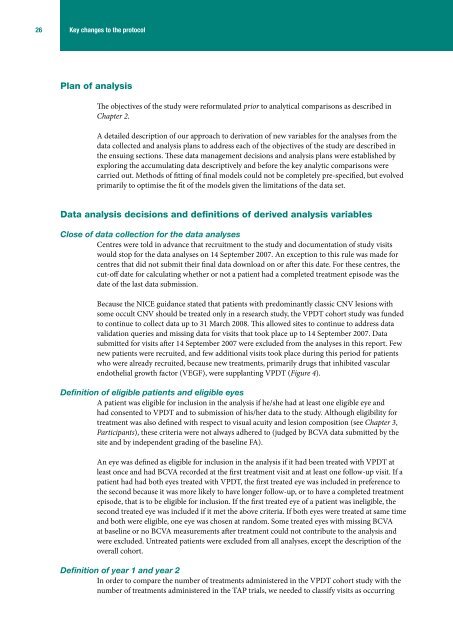Verteporfin photodynamic therapy for neovascular age-related ...
Verteporfin photodynamic therapy for neovascular age-related ...
Verteporfin photodynamic therapy for neovascular age-related ...
Create successful ePaper yourself
Turn your PDF publications into a flip-book with our unique Google optimized e-Paper software.
26 Key changes to the protocolPlan of analysisThe objectives of the study were re<strong>for</strong>mulated prior to analytical comparisons as described inChapter 2.A detailed description of our approach to derivation of new variables <strong>for</strong> the analyses from thedata collected and analysis plans to address each of the objectives of the study are described inthe ensuing sections. These data man<strong>age</strong>ment decisions and analysis plans were established byexploring the accumulating data descriptively and be<strong>for</strong>e the key analytic comparisons werecarried out. Methods of fitting of final models could not be completely pre-specified, but evolvedprimarily to optimise the fit of the models given the limitations of the data set.Data analysis decisions and definitions of derived analysis variablesClose of data collection <strong>for</strong> the data analysesCentres were told in advance that recruitment to the study and documentation of study visitswould stop <strong>for</strong> the data analyses on 14 September 2007. An exception to this rule was made <strong>for</strong>centres that did not submit their final data download on or after this date. For these centres, thecut-off date <strong>for</strong> calculating whether or not a patient had a completed treatment episode was thedate of the last data submission.Because the NICE guidance stated that patients with predominantly classic CNV lesions withsome occult CNV should be treated only in a research study, the VPDT cohort study was fundedto continue to collect data up to 31 March 2008. This allowed sites to continue to address datavalidation queries and missing data <strong>for</strong> visits that took place up to 14 September 2007. Datasubmitted <strong>for</strong> visits after 14 September 2007 were excluded from the analyses in this report. Fewnew patients were recruited, and few additional visits took place during this period <strong>for</strong> patientswho were already recruited, because new treatments, primarily drugs that inhibited vascularendothelial growth factor (VEGF), were supplanting VPDT (Figure 4).Definition of eligible patients and eligible eyesA patient was eligible <strong>for</strong> inclusion in the analysis if he/she had at least one eligible eye andhad consented to VPDT and to submission of his/her data to the study. Although eligibility <strong>for</strong>treatment was also defined with respect to visual acuity and lesion composition (see Chapter 3,Participants), these criteria were not always adhered to (judged by BCVA data submitted by thesite and by independent grading of the baseline FA).An eye was defined as eligible <strong>for</strong> inclusion in the analysis if it had been treated with VPDT atleast once and had BCVA recorded at the first treatment visit and at least one follow-up visit. If apatient had had both eyes treated with VPDT, the first treated eye was included in preference tothe second because it was more likely to have longer follow-up, or to have a completed treatmentepisode, that is to be eligible <strong>for</strong> inclusion. If the first treated eye of a patient was ineligible, thesecond treated eye was included if it met the above criteria. If both eyes were treated at same timeand both were eligible, one eye was chosen at random. Some treated eyes with missing BCVAat baseline or no BCVA measurements after treatment could not contribute to the analysis andwere excluded. Untreated patients were excluded from all analyses, except the description of theoverall cohort.Definition of year 1 and year 2In order to compare the number of treatments administered in the VPDT cohort study with thenumber of treatments administered in the TAP trials, we needed to classify visits as occurring
















